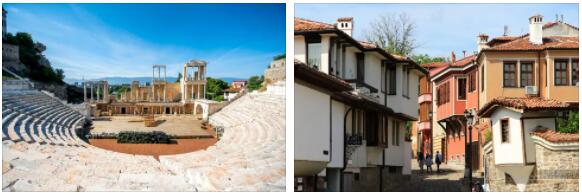Pleven (Bulgaria)
Pleven is located in the north of Bulgaria in the central part of the Danube plain near the river Vit. Most of this city is known in connection with the events of the Russian-Turkish war. About 200 monuments remind of the bloodiest battles that took place here.
In the center of the city is the Mausoleum-tomb of Russian and Romanian soldiers who died near Pleven. It was solemnly opened on September 16, 1907 in the presence of the commander of the Bulgarian militia. The architect of this monument is Pencho Koychev, and the carved linden iconostasis was made by Ivan Tryvnishkov. The iconostasis received high recognition at the Paris Exhibition in 1906.
Not far from the mausoleum is the Museum of the Liberation of Pleven. In the southwestern part of the city, on the site of old redoubts, a Skobelevsky park. Among the greenery and its alleys is the Mass Grave, in which thousands of Russian soldiers are buried. At the top of the hill in the park there is also the famous panorama “Pleven epic of 1877”. , created in the likeness of the Borodino panorama in Moscow. The combination of artistic painting, sculpture, authentic exhibits and explanatory texts gives a clear picture of the development of events, especially during the third assault on the city.
Not far from Skobelevsky Park are the Second Redoubt “Kovanlyk” and the Dead Valley, where over 6,000 Russian and Romanian soldiers died the death of the brave. A monument to Victory was erected on a high hill near the Vit River. Many memorable places associated with the Pleven epic are located in the vicinity of the city.
But not only military history is famous for Pleven. This is a very picturesque place. In the south of the city is Kaylyka Park. There are sheer cliffs, more than 20 m high, on which climbing competitions are held; rich vegetation, lakes, swimming pools, alleys, sports grounds, restaurant. This is a favorite vacation spot for residents and guests of the city.
Plovdiv (Bulgaria)
According to Topb2bwebsites.com, Plovdiv is located in Southern Bulgaria on the Maritsa River. It is picturesquely spread over the hills 25 km north of the Rhodope Mountains.
The first name given to the city by the Thracians was Eumolrios. When the city became a Roman possession, it was called Trimontium, which means three hills. Due to its location, it turns into a natural fortress, fortified with double stone walls. The settlement was included in the Bulgarian territories in the 10th century. during the reign of Simeon. In 1364 it falls into the hands of the Turks and is renamed Filibe. Gradually, the city becomes a large administrative and military center. The name “Plovdiv” appears in the 15th century. During the national revival of Plovdiv was already a significant cultural center. Today it is the second largest city in Bulgaria in terms of population, area and importance after Sofia.
Plovdiv is rich in archaeological sites. Among them are excavations of Neolithic and Bronze Age settlements, the Roman Forum, a theater, a stadium, temples, baths, and acropolises. Antique theater with 3,000 seats, built in the II century. AD Emperor Marcus Aurelius, is the best preserved monument of those times on Bulgarian soil. The theater has been restored and hosts various performances and festivals again.
Old Plovdiv was built in the 19th century. Today it is an open-air architectural museum with more than 150 exhibits. Magnificent houses have been turned into museums, galleries, restaurants. It also houses the studios of artists and wood carvers. The most striking examples of baroque houses in Plovdiv are the Kuyumdzhiugly house (now an ethnographic museum), the Nedkovich house (municipality), the Lamartin house (Writers’ House). Walking around Old Plovdiv, you can walk along steep, winding streets, with decorated facades, lots of greenery and flowers, fruit trees, evergreen shrubs and roses. In the central part of the Old City are the fortified walls of Philippopolis. Imaret mosques have been standing in Plovdiv
since the Turkish ruleand Dzhumaya (1444 – 1445), as well as one of the oldest clock towers in Europe. The Bulgarian Revival era includes the churches of St. Nedelya, St. Dimitar (both 1831) and St. Marina (1853-1854).
The most valuable works of art of that time are carved gilded iconostases and icons by Zakhary Zograf, an outstanding master of church and monastery painting, they can be seen in the churches of St. Helena and St. Constantine (1832).
The Maritsa River also has its place in the appearance of the city, which divides it into two uneven parts connected by six bridges. In the northern, smaller part, on the banks of the river, there is Fair town. Back in 1892, the First Bulgarian Exhibition was organized, which later developed into the International Plovdiv Fair. Currently, the fair is held twice a year – in early May (for consumer goods) and in September (for industrial goods).
